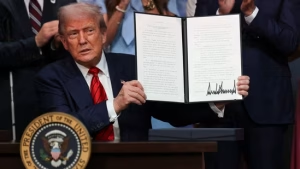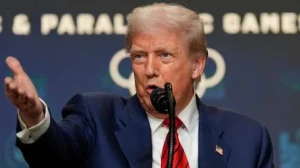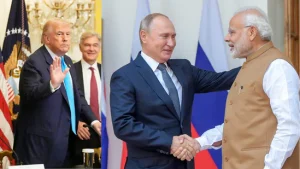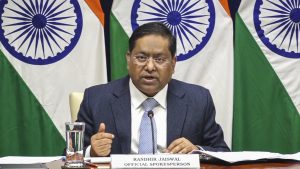Washington D.C. – US President Donald Trump has signed a significant Trump executive order tariff imposing an additional 25 percent duty on Indian imports, effectively doubling the existing tariff burden on New Delhi. This decisive action brings the total tariff rate on Indian goods to 50 percent, representing one of the most severe economic measures implemented against a major trading partner in recent years.
The Trump executive order tariff specifically targets India’s continued purchase of Russian oil, demonstrating the administration’s determination to use economic weapons to pressure countries maintaining energy relationships with Moscow. This executive action follows Trump’s earlier warnings during a CNBC interview where he threatened to “substantially raise” tariffs on India within 24 hours.
Background and Justification for Enhanced Tariffs

The Trump executive order tariff builds upon existing national emergency declarations related to Russian actions in Ukraine. The White House order references Executive Order 14066 of March 8, 2022, which expanded the scope of national emergency measures to address the “unusual and extraordinary threat to the national security and foreign policy of the United States.”
According to the official documentation, the Trump executive order tariff determination stems from additional information received from senior officials regarding Russian Federation actions in Ukraine. The President concluded that imposing additional tariffs on India would “more effectively deal with the national emergency” created by Russian activities.
The Trump executive order tariff specifically identifies India as a country “directly or indirectly importing Russian Federation oil,” providing the legal basis for enhanced economic sanctions. This classification places India alongside other nations facing secondary sanctions for maintaining energy trade relationships with Moscow.
Detailed Implementation Timeline and Scope


The Trump executive order tariff includes specific implementation timelines designed to provide businesses with adequate adjustment periods. The additional 25 percent ad valorem duty will become effective 21 days after the order’s signing, applying to goods entered for consumption or withdrawn from warehouse consumption.
Also Read: Strong Trump Justification Of Penalty On India, says ‘Never Said Percentage’
However, the Trump executive order tariff includes transitional provisions for goods already in transit. Items loaded onto vessels and in final transit mode before the effective date will be exempt if entered for consumption before September 17, 2025, providing limited relief for existing commercial arrangements.
The comprehensive nature of the Trump executive order tariff applies to all “articles of India imported into the customs territory of the United States,” indicating broad coverage across multiple sectors and industries without specific exemptions for particular products or categories.
Legal Authority and Constitutional Basis
The Trump executive order tariff derives its authority from multiple federal statutes, including the International Emergency Economic Powers Act (IEEPA), the National Emergencies Act, and section 604 of the Trade Act of 1974. This comprehensive legal foundation demonstrates the administration’s careful preparation for potential legal challenges.
The invocation of emergency powers for the Trump executive order tariff reflects the administration’s characterization of Indian energy trade with Russia as a national security threat. This approach allows the President to bypass normal congressional procedures for tariff implementation while claiming urgent national security justifications.
The Trump executive order tariff represents an expansion of existing Ukraine-related emergency declarations, linking Indian commercial activities to broader geopolitical conflicts and American foreign policy objectives in Eastern Europe.
Economic Impact and Trade Relationship Consequences


The Trump executive order tariff effectively doubles the cost burden on Indian exporters seeking American market access. Combined with the existing 25 percent tariff, Indian goods now face a 50 percent duty rate, potentially making many products uncompetitive in the US market.
This Trump executive order tariff targets one of America’s significant trading partners, with India maintaining substantial export relationships across multiple sectors including textiles, pharmaceuticals, automotive components, and technology services. The enhanced tariff burden could disrupt established supply chains and commercial relationships.
The timing of the Trump executive order tariff coincides with ongoing bilateral trade negotiations, potentially complicating diplomatic efforts to resolve broader trade disputes between Washington and New Delhi while adding economic pressure for policy changes.
India’s Strong Diplomatic Counter-Response
India’s Ministry of External Affairs has responded forcefully to the Trump executive order tariff, characterizing American actions as “unjustified and unreasonable.” This diplomatic pushback demonstrates New Delhi’s determination to defend its sovereign right to maintain diverse energy partnerships.


The MEA’s response to the Trump executive order tariff includes accusations that the United States and European Union are unfairly targeting India while maintaining their own trade relationships with Russia in various sectors. This counter-narrative challenges American moral authority in implementing secondary sanctions.
India’s criticism of the Trump executive order tariff reflects broader concerns about economic sovereignty and the extraterritorial application of American sanctions policies. New Delhi has consistently argued that its energy diversification serves global market stability rather than supporting Russian military activities.
Future Implications and Escalation Risks
The Trump executive order tariff establishes a precedent for using emergency powers to target countries maintaining energy relationships with sanctioned nations. This approach could influence future American responses to similar situations involving other strategic partners and adversaries.
The success or failure of the Trump executive order tariff in changing Indian behavior will likely influence the administration’s approach to other countries maintaining Russian energy relationships, including China and several European nations that continue importing Russian energy products through various channels.

